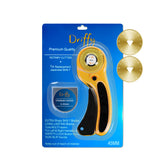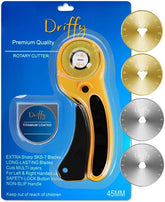Sewing Quilt Borders Accurately
When you’re sewing a quilt, it’s not abnormal for the finished four edges to end up slightly different lengths.
This is usually because the material can end up stretched out of shape when it’s being put together and sewn.
If the quilt you’re sewing isn’t quite accurate, and you measure the sides of the quilt to work out the length of the border, the quilt will be just as out of square as it was before any borders are sewn into place.
Measuring the quilt differently will allow you to square the borders up properly. This technique can be used on any type of border on any quilt.
Straight sewn borders
Straight sewn quilt borders are easy to learn and quick to sew, they’re the most common type of border used to sew quilts. are quick and easy to sew.
Borders are usually sewn onto the two longest sides of the quilt first, before then attempting to sew the two sides that are left.
The final two will extend straight across the ends of the first borders.
Check the length of your straight sewn borders
Measure the quilt from top to bottom making sure you do this through it’s vertical midpoint.
Now cut two border strips, making sure they match the measurements exactly.
If your borders are made with crosswise grain strips you’ll find these are somewhat more stretchy than border strips with a lengthwise grain, but either type is suitable.
Piecing for Length
You might find you need to piece border strips end-to-end to achieve the right length.
For each seam you sew, you’ll lose around quarter of an inch so make sure to allow a little extra when cutting.
Sew the strips along their ends, together. Press your seam allowances open to get rid of any bulk and then cut them so the the length matches the initial measurement you made.
Here, you can also place a diagonal seam in between each border strip, instead of a seam that runs across each the width of each strip.
Sew the strips using the strips with the same technique you’d use for continuous binding strips
Measuring your borders
You might need to experiment to find which method works best for you here.
Some quilters will measure a quilt’s length in multiple places before adding the lengths together and dividing by amount of measurements taken.
This will give them an average.
Think about sewing the borders to the short sides of a quilt first
Sometimes you might find it's best to add top and bottom borders first. This will negate the need to piece border strips.
Use the same method described above but measure horizontally first and begin at the shortest sides.
Determine which borders to sew first to make the best use of your fabric.
Sew The First Borders to the Quilt
To find the midpoint, fold one of the borders in half crosswise. Crease this with your fingers. In the right place.
From this, find the quilt’s horizontal mid point. With the right sides together and midpoint matches place the border along the right side of the quilt.
Pin and match the end of the border at the bottom, then do the same with the other end of the quilt.
Carry on pinning and matching the border to the quilt, making sure you pin at close intervals.
Any raw edges should be lined up with the quilts entire side. Making sure there’s a quarter inch seam allowance, sew the border to the quilt.
Make sure you remove pins as the needle approaches. Press the seam allowance to the border Now use the same method to sew the remaining border to the opposite side of the quilt.
Next you need to determine the remaining border length. To do this, measure the quilt from side-to-side through its horizontal midpoint.
Make sure you include the width of the first borders. Piece the two borders on that length. Fold a border in half crosswise and add in a crease.
From the midpoint of the border to the vertical midpoint of the top of the quilt, pin the sides together and make sure all the raw edges match.
Match and pin the border in the same way you attacked the side borders. Now sew this with a one quarter of an inch seam allowance and press this towards the border.
Repeat to sew the remaining border to the quilt and then repeat again for all your borders.











Leave a comment
Please note, comments need to be approved before they are published.